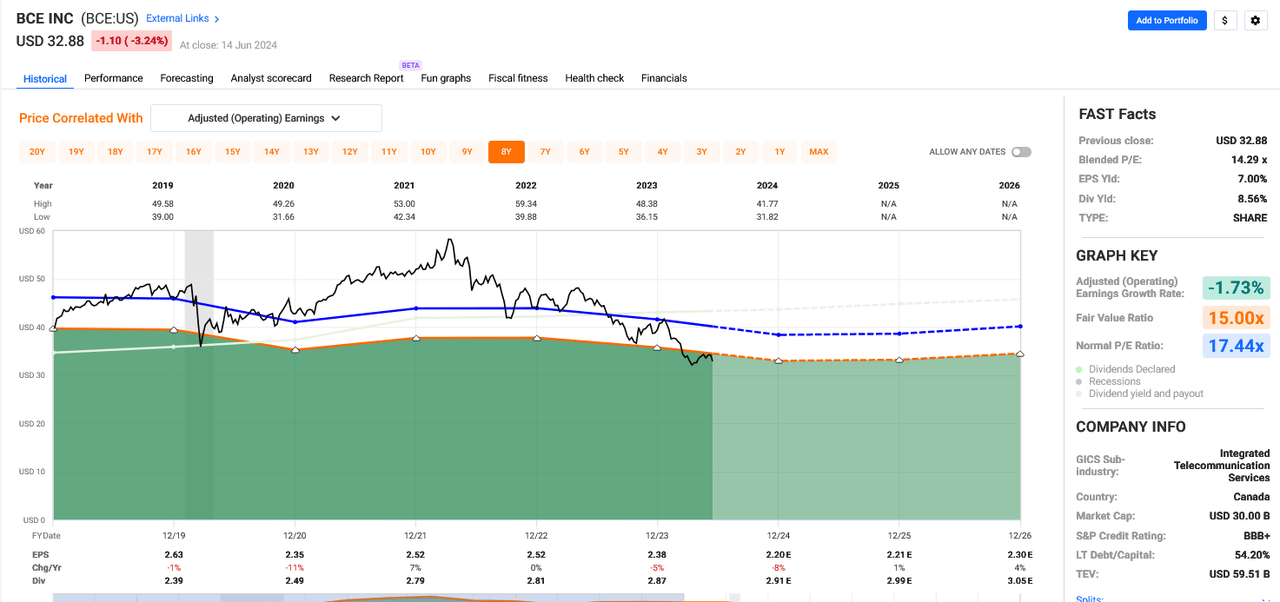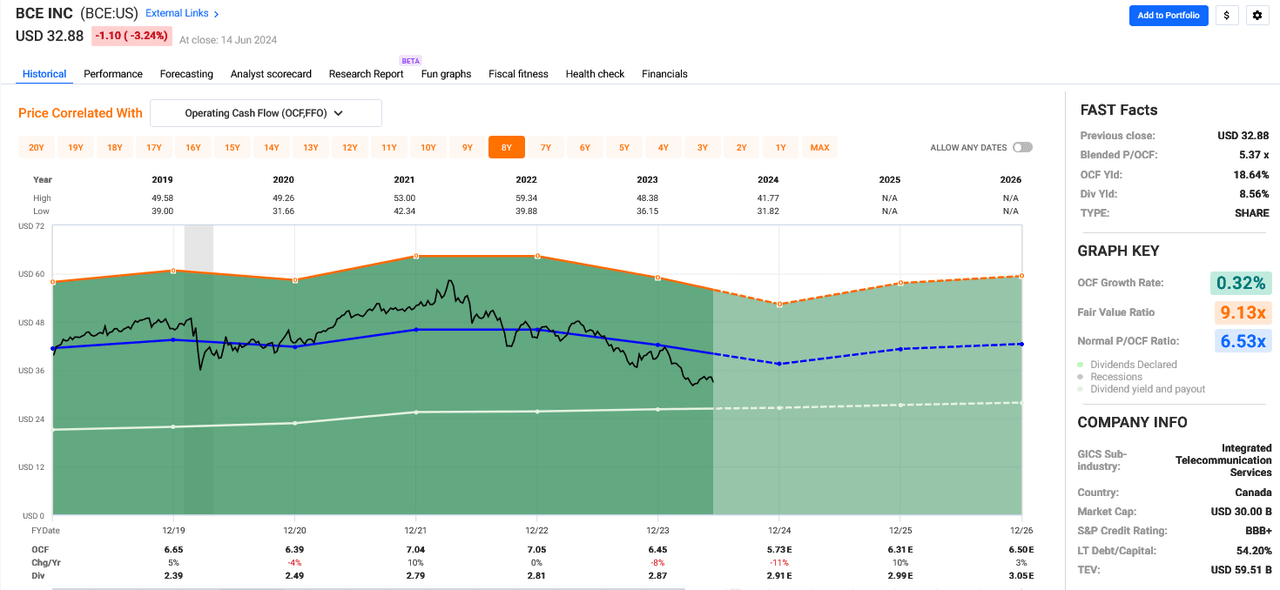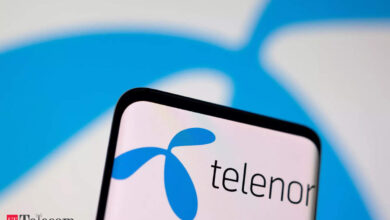BCE: Canadian Bell Rings With 8.9% Dividend Yield; 3 High Yield Telecommunication Stocks

nikom1234/iStock via Getty Images
The telecommunication companies in the communication sector generally stand out for high yield, with the 4 reviewed in this article being in that category. They also have investible S&P credit ratings along with 6%+ dividend yields. To note is that one of them is going to cut the dividend in 2025 and could still have a 6.1% yield. It is important to note that telecom service providers are not in favor, but what makes them popular to own is that they do provide quite reliable high-yield income.
Current prices with Morningstar and Value Line Price Targets
To introduce the tickers and names, I will start with some current prices and then pricing analyst estimates from Value Line and Morningstar. They should be used as points of reference as more information is revealed for each individual stock. BCE Inc. (NYSE:BCE) will be the focus of this article, but the others that also offer a bit lower high yield will get a shorter review. The “Rose Take and Recommendation” is provided for each one and will give you an idea of their future within the “RIG” portfolio.
Abbreviations used in the chart:
Current $Pr/Sh = US$ Price/Share on June 15, 2024.
M* = Morningstar Analyst premium subscriber information
M* FV = Fair Value from Morningstar analyst premium information.
M* Buy = the low buy price target suggested.
VL = Value Line analyst safety rating, with a 1 being the best, 3 average and 5 the worst.
MidPt Value = Value Line Price Target in US$ for the end of 2025.
|
S&P |
Stock |
Company |
Current |
M* |
M* |
VL |
MidPt |
|
CR |
Ticker |
Name |
$Pr/Sh |
FV |
Buy |
Value |
|
|
BBB+ |
(BCE) |
BCE, Inc. |
32.88 |
44.00 |
35.20 |
2 |
36 |
|
BBB |
(T) |
AT&T |
17.64 |
23.00 |
16.10 |
2 |
16 |
|
BBB+ |
(VZ) |
Verizon |
39.67 |
54.00 |
37.80 |
2 |
36 |
|
BBB |
(VOD) |
Vodafone Group |
8.74 |
15.00 |
10.50 |
3 |
8 |
BCE
BCE Inc.- 8.9% yield
BCE is the primary focus of this article getting more extensive coverage for its 8.9% dividend yield and that it is my most recent purchase, owning it along with all the rest. I had sold my shares last year when I wrote an article in May 2023 suggesting earnings were in decline and the dividend most likely would not rise much, if at all. The price most definitely sunk, while management allowed the dividend to stay intact and even raised it as promised. With that dividend promise in mind and earnings looking to stabilize, it is sitting pretty with that 8.9% yield and most likely a price below fair value. Statistics for P/E and earnings were obtained from Fast Graphs, a subscriber service I use.
It was founded in 1880 and is headquartered in Verdun, Canada, and it controls about 75% of the fixed line telecommunications network there.
At the end of 2023 It was at over 80% complete, bringing fiber connections to over 7 million homes and offers a competitive advantage for 5G that could drive future outperformance.
It is tied with the combined Canadian companies of Rogers/Shaw with currently having ~4.5 million internet customers.
It also has a top-grade high quality diversified media unit “Crave”, which offers video on demand including HBO, Showtime and Starz along with owning CTV and TSN “Top Sports”.
Earnings/Cash Flow
It reported a decrease in profits by 16% in Q1 2024 from Q1 2023 along with flat adjusted EBITDA. Increased depreciation and amortization expenses along with increased interest costs resulted in the lackluster profit and unfortunately, might just stay that way this year.
More on the positive side, revenues saw a slight improvement in the CTS segment or communications technology services for new mobile phones, increased internet subscribers and also seeing increased operating efficiencies that offset declines in legacy voice data satellite TV services.
The workforce reduction and restructuring from 2023 should start to show more positive cash flows later this year.
Analyst “Value Line” indicates full-year EBITDA should increase, but only by low single digits.
Headwinds/Negative Aspects
-Canadian increased regulatory rulings, especially for broadband.
-Addition of a 4th wireless competitor such as Quebecor
-Too much exposure to landline and video services
-Decreased satellite subscriptions
-Not owning its own media content and rising licensing costs for it.
Tailwinds/Positive Aspects
-Subscriber growth due to rising immigration from other countries
-Pension plans were fully funded at the end of 2023.
-The costs for Quebecor to create new lines and compete would be overwhelmingly expensive and most likely would mean they would need to acquire Freedom Mobile and its existing lines.
-Current customer reliance on wireless and broadband should continue and increase.
All in all, revenue growth is limited secondary to the competitive nature and could advance at low single digits or only ~2% yearly.
FAST Graphs – “FG”
The following colors/lines on the “FG” chart shown below represent:
Black line = price.
White line = dividend.
Orange line = Graham average of usually 15 P/E “price/earnings” for most stocks.
Blue line = Normal P/E.
Dashed or dotted lines are estimates only.
Green Area represents earnings.
Statistics by year are noted for high and low prices at the top of the chart in black, and for earnings and dividends at the bottom of it. The % shown is for the change from year to year for earnings, with an E after any number representing an estimate. The 8-year FG below is for 6 past years and 2 future estimates.
BCE Technical 8-year chart (FAST Graphs June 15, 2024)
The price has now sunk under the fair value orange line of 15 P/E. It currently sells at 14.29x, which is below the 17.44x normal blue line. That would make it undervalued by that metric.
The price decline most likely resulted from its poor earnings/decline over the last year and now into 2024. Earnings estimates look to stabilize and almost flat line through the rest of 2024 and then start growing ever so slightly in 2025.
Dividend
2018, 2019 and 2020 saw earnings declines, but the dividend was maintained and even raised, revealing management’s commitment to maintaining and even raising it. Good news for shareholders, but still somewhat unnerving when looking at the earnings chart and the dividend line in it.
The dividend white line can barely be seen in the FG above, as it does not appear in the green area of earnings. It is riding high above in the white area, which means it is not fully funded from earnings and has an actual payout per FG of 120.5% which has now been over 100% since 2020.
The good news is that long-term debt /capital is 54.2%, and it can continue funding the dividend if it so chooses. The leverage ratio is low and in line with its peers. It has been suggested stock repurchases might be a better use for its cash, but thus far management has indicated it is resolved to continue the dividend at its current level, which, again, is very good news for shareholders.
The 2023 dividend was $2.87 US and is estimated to be $2.91 for 2024, a 1.4% raise.
The 5-year DGR is 4.5%, but as mentioned above the raises are on a lower % raising trend, but 2024 is estimated by FG to rise by 2.7% to $2.99. I believe that to be generous, but most likely doable if one looks at cash flows.
Cash Flows FG
BCE Cash Flow 8-year technical chart (FAST Graphs June 15, 2024)
The FG above shows the dividend is covered and the P/OCF or Price/Operating Cash Flows is 5.37x, where the normal or blue line is 6.53x. Positively good news for the dividend.
Chowder #
C# = 5-year dividend growth rate + yield = 13.4, but remember telecoms only need an 8, so BCE passes on its yield alone, which is currently an amazing 8.9%.
Rose Take and Recommendation
The commitment by management to keep the dividend and even raise it along with the price falling below 15x P/E convinced me to start a position in March when it had an 8.5% yield. The M* Buy price above in the chart of $35.20, and it definitely is now below that. The now 8.9% is a great yield for anyone desiring income from a quality Canadian company, and I say it is a Buy. With telecoms being out of favor, capital gains might not be seen for years. Note the foreign tax is deferred in an IRA of any kind and can be recovered in a taxable account at tax time.
ATT Inc. – 6.3% yield
T provides telecommunication and technology services worldwide, including a Latin America segment that operates in Mexico. The company formerly known as SBC communications changed its name in 2005 to AT&T Inc, was incorporated in 1983 and is based in Dallas, TX. It has a $126.48B market cap.
It split off its owned portion of Warner Media (WBD) in April 2022 giving shareholders 0.024 shares for each T share owned and cut the T dividend to 27.75c/ quarter where it has been ever since.
Earnings look to be flat for now after falling the last 2-3 years. They sit at $2.22 per share for 2024 and are estimated to rise 3% to $2.30 in 2025 and up 6% to $2.44 in 2026.
It has a BBB S&P credit rating and has a stagnant dividend currently at $1.11 yearly, giving it at the $17.64 price a yield of 6.3%.
No dividend growth since the split in 2022.
The payout is 46%, so there could be room to raise the dividend.
Long-term debt/capital is 56.17%.
Cash flow P/OCF for 4 years is 4.12x, and it is currently at 3.36x, all good.
Chowder# is 6.3 based on its yield alone. With any type of dividend raise, it could rise to get to the passing grade of 8.
The current P/E is 7.59x and normal 5 years is 7.89x; therefore it sits very much at a stagnant level for price as well.
Rose Take and Recommendation
I own it, have held it a long time, don’t love it, but the income is fine. There are many better choices for income with higher yields, but those might also bear more risk. It provides reliable income at a better yield than most CDs. It is a buy if the price dips again, but for now, I keep it in RIG, it is a Hold.
Verizon – 6.7% yield
VZ engages in the providing communications, technology, information, and entertainment products for consumers and businesses worldwide. It was formerly known as Bell Atlantic Corporation “SBC” and changed its name to Verizon Communications in June 2000. It was incorporated in 1983, is headquartered in NY, NY. and has a BBB+ S&P credit rating. It has a $166.98B market cap.
Earnings started to fall in 2022 by 4% after being up 10% through 2021 at $5.31. However, earnings fell through 2023 by 9% and a smaller amount going into 2024, sitting now at a low of $4.60. 2025 & 2026 estimates look to rise by 3% each year, with $4.88 for 2026.
The P/E normal for 6 years is 10.39x, but has now shrunk to 9.31x for 4 years. It is currently selling at 8.51x. It is undervalued by that metric.
Long-term debt/capital is 57.69%.
Dividend payout is 55.68% which is very average and just fine.
Normal P/OCF is 4.99x, and it is now at 4.53x, which makes it all good for covering expenses and the dividend.
The 5-year DGR is 2% and the 10 year is also quite similar at 2.37%. It has paid rising dividends for 19 years.
C# = 8.7 and passes that test for purchase.
Rose Take and Recommendation
I sincerely have always liked this company and getting those 2% reliable raises. It’s staying, and if its price should dip again under $35, I recommend anyone without it consider owning it for income. $33.63 = 8% yield. That would be hard to ignore, even for me.
Vodafone Group – 11.1% yield
VOD offers services in the UK, Europe, Turkey, Germany and Africa. It most recently sold its operations in Italy for $4.5B and $1B in Preference Shares and Spain for $8.8B, while reducing its Indian joint venture by $2.4B. These divestitures will help move it to more share buybacks estimated to be $4.4B per the analyst “Value Line”.
It is agreed to combine the UK business with Three UK to create a third scaled network operator there. It has plans to merge with CK Hutchison and will own 51% of that advanced standalone 5G network.
Growth should rise, but from a smaller base and is hard to compare with past results. However, organic service revenues did grow by 6.3% in 2023.
Foreign companies like this one pay dividends only 2x per year.
Vodafone has an ex date in November to announce the dividend to be paid in February, which was 48.15c in 2024. It just had an ex-date on June 7th to announce the 48.601c it will pay August 2nd. This amounts to 96.75c for the 2024 year and gives it a yield of 11.1% at its current low price of $8.75.
Dividend Cut Coming
It is known and management has announced that the dividend will be cut by ~50% for 2025. Estimates indicate it most likely will be ~27c for each 2x yearly payment and takes the dividend yield down to ~6.1% if the price remains at $8.75. This yield is in line with most other telecoms.
Normal 4-year P/E is 11.39x, and it is 10.27x currently but would drop secondary to the recent divestitures. Earnings are estimated to rise back up slowly to the 2023 level of $1.22 sometime in 2027.
Long-term debt to capital is 41.32%.
4 years P/OCF is 2.09x and stands at 1.54x today and should do well with the dividend cut.
Total return prospects, even with the dividend cut, look to offer good return over a 3-5 year span.
C# = 11.1 which passes alone with its current yield, but not into the future with the anticipated dividend cut.
Rose Take and Recommendation
It is interesting to note that M* has the buy price at $10.50, which is higher than the $8.75 now, which is encouraging and shows potential. It is a real conundrum, offering good income even with a future dividend cut. At least management is honest and foretold the event and is streamlining this very complex, overgrown company. I admit to being disappointed for some years with the price and would consider streamlining my holdings if it should rise higher, which is doubtful. The price now is low and if it goes lower to $6.75 or 8% yield, it would be a screaming buy. I will continue to hold with full knowledge of a dividend cut in 2025.
Summary/Conclusion
Defense in an income portfolio also means buying at great value, quality companies with reliable dividends that provide good income. All 4 of these telecom companies have good S&P credit ratings and provide some income defense with their high yields. Capital gains will not be forthcoming quickly with any of these companies. Raises are always welcome, and so patience for the right buy price is sometimes the hardest to conquer for most investors to bring in a higher total return. The “RIG”/ Rose’s Income Garden portfolio was built with patience and great value. Value is up 6.61% YTD and beating SPY by 3.33% since inception November 2021. It also has a dividend yield of 6.2% and therefore dividends for income remains a strong driver for the 85-stock portfolio. These 4 telecom stocks will remain for now in the “RIG” portfolio, as they meet most requirements for membership.



